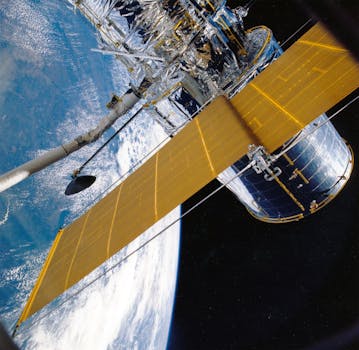From Geostationary to Low Earth Orbit: The Evolution of Satellite Telecommunications in 2023

From Geostationary to Low Earth Orbit: The Evolution of Satellite Telecommunications in 2023
Introduction to Satellite Telecommunications
Satellite telecommunications, also known as satcom, has been a crucial part of the global telecommunications infrastructure for decades. The technology uses artificial satellites in orbit around the Earth to transmit and receive data, voice, and video signals. Over the years, the industry has undergone significant changes, with advancements in technology and shifts in market demand driving the evolution of satellite telecommunications.
From Geostationary to Low Earth Orbit: The Evolution of Satellite Telecommunications in 2023 is a significant development in the field of telecommunications. The focus keyword, satellite telecommunications, is a crucial aspect of this evolution, as it enables the provision of high-speed internet, voice, and data services to remote and underserved areas.
The Shift from Geostationary to Low Earth Orbit
Traditionally, satellite telecommunications have relied on geostationary satellites, which are placed in a geostationary orbit, approximately 36,000 kilometers above the equator. These satellites have a fixed position in the sky and are used for a variety of applications, including television broadcasting, telecommunications, and weather forecasting. However, geostationary satellites have some limitations, including high latency, which can range from 600 to 800 milliseconds, and limited bandwidth capacity.
In recent years, there has been a significant shift towards low earth orbit (LEO) satellites, which are placed in an orbit between 160 and 2,000 kilometers above the Earth. LEO satellites have several advantages over geostationary satellites, including lower latency, which can be as low as 20 milliseconds, and higher bandwidth capacity. This makes LEO satellites ideal for applications that require real-time communication, such as video conferencing, online gaming, and remote healthcare.
Benefits of Low Earth Orbit Satellites
The shift to LEO satellites has brought about numerous benefits to the satellite telecommunications industry. Some of the key benefits include faster internet speeds, lower latency, and increased accessibility. LEO satellites are also more cost-effective than geostationary satellites, as they require less powerful transmitters and can be launched into orbit at a lower cost.
Another significant benefit of LEO satellites is their ability to provide global coverage, including in remote and underserved areas. This has opened up new opportunities for satellite telecommunications, including the provision of high-speed internet services to rural and remote communities, as well as the support of emergency response and disaster relief efforts.
Challenges and Future Developments
While the shift to LEO satellites has brought about numerous benefits, there are also some challenges that need to be addressed. One of the key challenges is the need for a large constellation of satellites to provide global coverage, which can be complex and expensive to deploy and maintain. Additionally, there are concerns about the potential for space debris and the impact of LEO satellites on the environment.
Despite these challenges, the future of satellite telecommunications looks promising, with ongoing developments in technology and investments in new satellite constellations. Some of the key future developments include the launch of new satellite constellations, such as the SpaceX Starlink and Amazon Kuiper Systems, which are expected to provide high-speed internet services to remote and underserved areas.




